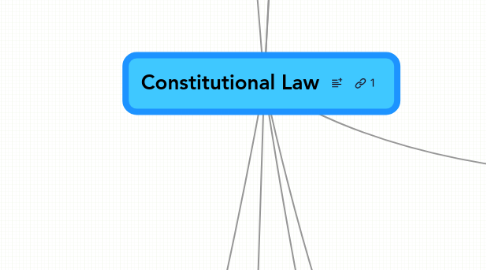
1. Separation of Powers
1.1. Congressional Power
1.1.1. Procedure
1.1.2. Powers
1.1.2.1. Commerce Power
1.1.2.2. Taxing Power
1.1.2.3. Spending Power
1.1.2.4. War and Defense Power
1.1.2.5. Other Powers
1.2. Executive Power
1.2.1. Chief Executive
1.2.1.1. Enforcement Power
1.2.1.2. Appointment Power
1.2.1.3. Removal Power
1.2.1.4. Veto Power
1.2.1.5. Pardon Power
1.2.1.6. Executive Privilege
1.2.2. Commander in Chief
1.2.2.1. Military Powers
1.2.3. International Affairs
1.2.3.1. Treaty Power
1.2.3.2. Executive Agreement
1.3. Checks and balances
1.3.1. Congressional Limits on the Executive
1.3.2. Presidential Limits on Congress
1.3.3. Judicial Limits on congress/President
2. Equal Protection of the Laws
2.1. Suspect Classifications
2.1.1. Strict Scrutiny
2.1.1.1. Race
2.1.1.2. State - Alienage
2.1.1.3. Due Process
2.1.1.4. Exception - Neutral on Its Face
2.1.2. Intermediat Scrutiny
2.1.2.1. Illegitimacy
2.1.2.2. Gender
2.1.2.3. Illegal Alien Children
2.1.2.4. Affirmative Action
2.1.3. Rational Basis
2.1.3.1. Federal - Alienage
2.1.3.2. Age
2.2. Privileges and Immunities
2.2.1. 14th Amendment
2.2.2. Commity Clause, Article 4
3. First Amendment
3.1. Freedom of Religion
3.1.1. Establishment Clause
3.1.1.1. Strict Scrutiny or Lemon Test
3.1.1.2. Religious Activities conducted at public School
3.1.1.3. Government Aid to School
3.1.2. Free Exercise Clause
3.1.2.1. Beliefs
3.1.2.2. Conduct
3.2. Freedom of Expression
3.2.1. Permissible Regulation of Speech
3.2.1.1. Strict Scrutiny
3.2.1.1.1. Content Based
3.2.1.1.2. View Point Based
3.2.1.2. Exceptions
3.2.1.2.1. Conduct regulation
3.2.1.2.2. Govt as Speaker
3.2.1.2.3. Unprotected Speech
3.2.1.2.4. Time, Place, and Manner
3.2.2. Public Employment
3.2.3. Prior Restraint
3.2.3.1. Overbreadth
3.2.3.2. Vagueness
3.2.3.3. Unfettered Discretion by licensing official
3.2.4. Press
4. Federal Court Jurisdictions
4.1. Types
4.1.1. Constitution, federal law, treaties
4.1.2. ambassadors, public ministers
4.1.3. admiralty
4.1.4. US a party
4.1.5. between factors
4.1.6. between state and citizen of another state
4.1.7. diversity
4.2. Limitations
4.2.1. Case or controversy
4.2.1.1. real disputes
4.2.1.2. adverse parties
4.2.1.3. can be resolved by judicial decree
4.2.2. mootness
4.2.3. ripeness
4.2.4. abstention
4.2.5. standing
4.2.5.1. Third Party
4.2.5.2. Association
4.2.5.3. Elements
4.2.5.3.1. redressability
4.2.5.3.2. Injury in fact
4.2.5.3.3. causation
4.2.6. political question
4.3. US Supreme Court
4.3.1. Original Jurisdiction
4.3.2. Appellate Jurisdiction
5. Federalism
5.1. Immunity of Federal Government
5.2. Immunity of State Government
5.3. Authority Reserved for the States
5.3.1. Dormant Commerce Clause
5.3.1.1. State Tax - interstate
5.3.1.1.1. Market Participant Exception
5.4. Preemption
6. Retroactive
6.1. State Action is Required
6.2. Contract Clause
6.3. Ex Post Facto Laws
6.4. Bill of Attainder
7. Due Process
7.1. Which Provisions to Rely On?
7.2. Content of the Rights
7.2.1. Procedural Protection
7.2.1.1. Life Liberty or Property
7.2.1.2. What Process is Due
7.2.2. Substantive Protection - CAMPER
7.2.2.1. Economic Regulation
7.2.2.2. Fundamental Rights
7.2.2.3. Abortion with Undue Burden
7.2.2.4. Family Relations
7.2.2.5. Sexual Orientation
7.2.2.6. Other Rights
7.2.2.7. Right to Vote
8. Constitutional Powers
8.1. 10th
8.2. Priv. and Imm. Clause of Article IV
8.3. 5th
8.4. 11th
8.5. 13th
8.5.1. Enabling Clause
